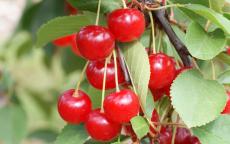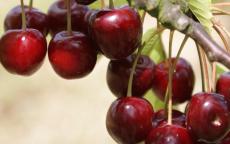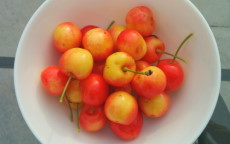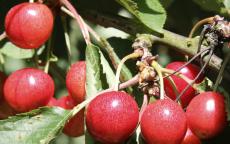- Sub-categories:
- Sweet cherry trees9
- Tart cherry trees5
Cherry trees
Cherry trees are an excellent choice for the garden because they are at their best when eaten straight from the tree.
Balaton
A late-season tart cherry, great for pies and jams, with a sweet tangy flavor and high sugar content - can also be eaten out of hand.- Picking season: Late
- Self-fertility: Self-fertile
- Fruit color: Red - dark
BlackGoldTM
BlackGold is an early/mid-season self-fertile sweet black cherry.- Picking season: Mid
- Self-fertility: Self-fertile
- Fruit color: Black
- Fruit color: Red / Black
BlackPearl®
BlackPearl is an early season dark cherry with a firm flesh and sweet flavor.$41.95buy- Picking season: Early
- Self-fertility: Not self-fertile
- Fruit color: Red / Black
Danube
An attractive red tart cherry which can also be eaten fresh.- Picking season: Mid
- Self-fertility: Partially self-fertile
- Fruit color: Red
Hedelfingen
An old European sweet cherry, which is well-suited to the North American climate and widely-grown.- Picking season: Mid
- Self-fertility: Not self-fertile
- Fruit color: Red / Black
Hudson
Hudson is a late-season red/black cherry, with some resistance to fruit splitting.- Picking season: Late
- Self-fertility: Not self-fertile
- Fruit color: Red / Black
Montmorency
If you want to make a traditional American cherry pie, Montmorency is the variety you need.- Picking season: Late
- Self-fertility: Self-fertile
- Fruit color: Red
Rainier
Rainier is a firm but juicy cherry with a good flavor.- Picking season: Early
- Self-fertility: Not self-fertile
- Fruit color: Yellow
Regina
Regina is a popular and productive late-season sweet cherry.- Picking season: Late
- Self-fertility: Not self-fertile
- Fruit color: Black
- Fruit color: Red / Black
StardustTM
Stardust is a new mid-season self-fertile blush cherry.- Picking season: Early
- Self-fertility: Self-fertile
- Fruit color: Orange / Red
Surefire
Surefire is a late-bloom and late-ripening tart cherry.- Picking season: Late
- Self-fertility: Self-fertile
- Fruit color: Red
Sweetheart
Sweetheart is a self-fertile sweet cherry, which ripens late in the season.$39.95 - $41.95buy- Picking season: Late
- Self-fertility: Self-fertile
- Fruit color: Red
WhiteGold®
A white-fleshed sweet cherry, self-fertile, and ripening in the mid-season, and productive - an ideal cherry tree for the backyard orchard.- Picking season: Mid
- Self-fertility: Self-fertile
- Fruit color: Yellow / Red
How to choose Cherry trees
Cherries are perhaps the most diverse member of the genus Prunus, which includes other popular stone fruits such as plums, peaches, and apricots. There are two main types, the sweet cherry Prunus avium (best for eating fresh) and the acid or sour cherry Prunus cerasus (best for cooking).
Cherry trees are generally easy to grow, but sweet cherries like sun, so choose a sunny aspect when planting. They generally do best in zones 4-8.
All cherries prefer well-drained soil, so avoid areas that are prone to water-logging. The most serious disease affecting cherry trees is bacterial canker, and this tends to be more aggressive in wet soils.
The other main horticultural challenge is bird protection. It's a foregone conclusion that birds will get your cherry crop before you do, because they are prepared to eat slightly un-ripe cherries whereas humans are not. However the simple precaution of netting the trees just before the harvest will solve this problem - on very large and inaccessible trees drape a net over some of the lower branches, allowing the birds to take their share from the higher branches.
Cherry trees do not need much attention as they grow, a simple mulch to keep the area free of weeds is sufficient. Once fruiting begins the mulch remains important, and should be extended to match the spread of the branches, because it acts as a sponge and therefore helps prevent fruit-splitting after heavy downpours. You should also apply compost and/or manure during the winter to supply the tree with the nutrients it needs for growth and fruiting.
Provided you can keep the birds off, cherry trees make a good choice for the garden because cherries are a fruit that is best eaten straight from the tree - sweet cherries do not keep more than a day or so and the flavour fades very rapidly. Shop-bought cherries are often quite expensive, and can never be as fresh as those you pick from your own tree.




